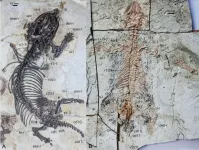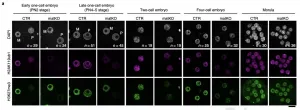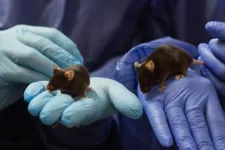INFORMATION:
This study was supported by the National Natural Science Foundation of China, the Chinese Academy of Sciences Strategic Priority Research Program, the Youth Innovation Promotion Association, and the Kalbfleisch Fellowship of the American Museum of Natural History's Richard Gilder Graduate School.
Contact: PhD candidate at the Faculty of Medicine, University of Bergen, Einar Marius Hjellestad Martinsen - e-mail - Einar.martinsen@uib.no - cell phone - +4797788414
Scientists discover two new species of ancient, burrowing mammal ancestors
120-million-year-old animals evolved 'scratch digging' traits independently
2021-04-07
(Press-News.org) A joint research team led by Dr. MAO Fangyuan and Dr. ZHANG Chi from the Institute of Vertebrate Paleontology and Paleoanthropology (IVPP) of the Chinese Academy of Sciences and Prof. MENG Jin from the American Museum of Natural History have discovered two new species of mammal-like, burrowing animals that lived about 120 million years ago in what is now northeastern China.
The new species, described in Nature on April 7, are distantly related. However, they independently evolved traits to support their digging lifestyle. They represent the first "scratch diggers" discovered in this ecosystem.
"There are many hypotheses about why animals dig into the soil and live underground," said Prof. MENG, lead author of the study. "For protection against predators, to maintain a temperature that's relatively constant, or to find food sources like insects and plant roots. These two fossils are a very unusual, deep-time example of animals that are not closely related and yet both evolved the highly specialized characteristics of a digger."
The fossil mammaliamorph species--predecessors to mammals--were discovered in the Jehol Biota, which represents the Early Cretaceous epoch, about 145 to 100 million years ago.
One is a mammal-like reptile called a tritylodontid and represents the first of its kind to be identified in this biota. About a foot in length, it was named Fossiomanus sinensis. The other one, Jueconodon cheni, is a eutriconodontan, a distant cousin of modern placental mammals and marsupials, which were common in the biota. It is about seven inches long.
Mammals that are adapted to burrowing have specialized traits for digging. The researchers found some of these hallmark features, including shorter limbs, strong forelimbs with robust hands, and a short tail, in both Fossiomanus and Jueconodon. In particular, these characteristics point to a type of digging behavior known as "scratch digging," accomplished mainly by the claws of the forelimbs.
"This is the first convincing evidence for fossorial life in those two groups," said Dr. MAO. "It also is the first case of scratch diggers we know about in the Jehol Biota, which was home to a great diversity of animals, from dinosaurs and insects to plants."
The animals also share another unusual feature: an elongated vertebral column. Typically, from the neck to the hip, mammals have 26 vertebrae. However, Fossiomanus had 38 vertebrae--a staggering 12 more than the usual number--while Jueconodon had 28.
To try to determine how these animals got their elongated axial skeleton, the paleontologists turned to recent studies in developmental biology, finding that the variation could be attributed to gene mutations that determine the number and shape of the vertebrae during early embryonic development of these animals. Variation in vertebrae number can be found in modern mammals as well, for example, in elephants, manatees, and hyraxes.
ELSE PRESS RELEASES FROM THIS DATE:
Study finds late night snacks may hurt your workplace performance
2021-04-07
A recent study finds that unhealthy eating behaviors at night can make people less helpful and more withdrawn the next day at work.
"For the first time, we have shown that healthy eating immediately affects our workplace behaviors and performance," says Seonghee "Sophia" Cho, corresponding author of the study and an assistant professor of psychology at North Carolina State University. "It is relatively well established that other health-related behaviors, such as sleep and exercise, affect our work. But nobody had looked at the short-term effects of unhealthy eating."
Fundamentally, the researchers had two questions: Does unhealthy eating behavior affect you at work the next day? And, if so, why?
For the study, ...
Inheriting acquired traits requires trailblazer modifications to unfertilized eggs
2021-04-07
An epigenetic study at the RIKEN Center for Integrative Medical Sciences shows that in mouse egg cells, modifications to histone H2A at lysine 119 lay the groundwork for inherited DNA functional modifications from the mother.
In books and the movies, a group of people on a special mission always sends out a scout to do reconnaissance before they proceed. Sometimes, the scouts leave signs or markers that allow the group to know where there should go. Researchers led by Azusa Inoue at the RIKEN Center for Integrative Medical Sciences in Japan have discovered a mark left behind in unfertilized egg cells that determine which DNA modifications ...
A new mouse model gave surprising findings about Folling Disease
2021-04-07
In Norway, all newborn children are tested for 25 rare genetic diseases through the Newborn Screening program, and the most common of these is phenylketonuria (abbreviated to PKU), known as Folling Disease.
Every year, between 3-7 children are born in Norway with PKU, and this diagnosis has a great impact on the rest of their lives. People with PKU must follow a very strict diet all their lives, where they must avoid almost all foods that contain proteins.
"Failure to implement the diet from birth may result in irreversible physical problems and brain damage, and optimal brain function requires life-long adherence", explains Professor ...
UMD tracks the adoption of green infrastructure, from water conservation to policy
2021-04-07
In a new paper published in the Journal of Environmental Policy & Planning, the University of Maryland teamed up with local researchers to examine green infrastructure adoption and leadership in Tucson, Arizona, an interesting case study where grassroots efforts have helped to drive policy change in a growing urban area surrounded by water-constrained desert. Green infrastructure (any installation that manages water or environmental factors, such as rain gardens, stormwater basins, or urban tree cover) is slowly transitioning from a fringe activity to an important part of the way governments and municipalities are dealing with water and the local effects of a changing climate. By examining ...
Study revises understanding of cancer metabolism
2021-04-07
Tumors consume glucose at high rates, but a team of Vanderbilt researchers has discovered that cancer cells themselves are not the culprit, upending models of cancer metabolism that have been developed and refined over the last 100 years.
Instead, non-cancer cells in a tumor -- primarily immune cells called macrophages -- have the highest glucose uptake, the group reported April 7 in the journal Nature. The findings that different cells in the tumor microenvironment use distinct nutrients according to their own metabolic programs could be exploited to develop new therapies and imaging strategies, ...
Early indicators of magma viscosity could help forecast a volcano's eruption style
2021-04-07
Washington, DC-- The 2018 eruption of Kīlauea Volcano in Hawai'i provided scientists with an unprecedented opportunity to identify new factors that could help forecast the hazard potential of future eruptions.
The properties of the magma inside a volcano affect how an eruption will play out. In particular, the viscosity of this molten rock is a major factor in influencing how hazardous an eruption could be for nearby communities.
Very viscous magmas are linked with more powerful explosions because they can block gas from escaping through vents, allowing pressure ...
Childhood cognitive problems could lead to mental health issues in later life
2021-04-07
Children experiencing cognitive problems such as low attention, poor memory or lack of inhibition may later suffer mental health issues as teenagers and young adults, a new study reveals.
Targeting specific markers in childhood for early treatment may help to minimise the risk of children developing certain psychopathological problems in adolescence and adult life, such as borderline personality disorder, depression and psychosis.
Cognitive deficits are core features of mental disorders and important in predicting long-term prognosis - the researchers' work indicates that individual patterns of such deficits predate ...
Ocular assessments of newborns gestationally exposed to maternal COVID-19 infection
2021-04-07
What The Study Did: This case series examines whether maternal SARS-CoV-2 is associated with outcomes in the eyes of their newborns.
Authors: Olívia Pereira Kiappe, M.D., M.Sc., of Universidade Federal de São Paulo in Brazil, is the corresponding author.
To access the embargoed study: Visit our For The Media website at this link https://media.jamanetwork.com/
(doi:10.1001/jamaophthalmol.2021.1088)
Editor's Note: Please see the article for additional information, including other authors, author contributions and affiliations, conflict of interest and financial disclosures, ...
Association of race/ethnicity, sex, income with well-being during COVID-19
2021-04-07
What The Study Did: This observational study identifies and quantifies the association of race/ethnicity, sex and income, as well as state-specific lockdown measures, with six well-being dimensions in the United States.
Authors: Leigh C. Hamlet, B.S., of the University of Washington in Seattle, is the corresponding author.
To access the embargoed study: Visit our For The Media website at this link https://media.jamanetwork.com/
(doi:10.1001/jamanetworkopen.2021.7373)
Editor's Note: The article includes funding/support disclosures. Please see the article for additional information, including other authors, author contributions and affiliations, conflict of interest and financial disclosures, ...
The muon's magnetic moment fits just fine
2021-04-07
A new estimation of the strength of the magnetic field around the muon--a sub-atomic particle similar to, but heavier than, an electron--closes the gap between theory and experimental measurements, bringing it in line with the standard model that has guided particle physics for decades.
A paper describing the research by an international team of scientists appears April 8, 2021 in the journal Nature.
Twenty years ago, in an experiment at Brookhaven National Laboratory, physicists detected what seemed to be a discrepancy between measurements of the muon's "magnetic ...
LAST 30 PRESS RELEASES:
SIMJ announces global collaborative book project in commemoration of its 75th anniversary
Air pollution exposure and birth weight
Obstructive sleep apnea risk and mental health conditions among older adults
How talking slows eye movements behind the wheel
The Ceramic Society of Japan’s Oxoate Ceramics Research Association launches new international book project
Heart-brain connection: international study reveals the role of the vagus nerve in keeping the heart young
Researchers identify Rb1 as a predictive biomarker for a new therapeutic strategy in some breast cancers
Survey reveals ethical gaps slowing AI adoption in pediatric surgery
Stimulant ADHD medications work differently than thought
AI overestimates how smart people are, according to HSE economists
HSE researchers create genome-wide map of quadruplexes
Scientists boost cell "powerhouses" to burn more calories
Automatic label checking: The missing step in making reliable medical AI
Low daily alcohol intake linked to 50% heightened mouth cancer risk in India
American Meteorological Society announces Rick Spinrad as 2026 President-Elect
Biomass-based carbon capture spotlighted in newly released global climate webinar recording
Illuminating invisible nano pollutants: advanced bioimaging tracks the full journey of emerging nanoscale contaminants in living systems
How does age affect recovery from spinal cord injury?
Novel AI tool offers prognosis for patients with head and neck cancer
Fathers’ microplastic exposure tied to their children’s metabolic problems
Research validates laboratory model for studying high-grade serous ovarian cancer
SIR 2026 delivers transformative breakthroughs in minimally invasive medicine to improve patient care
Stem Cell Reports most downloaded papers of 2025 highlight the breadth and impact of stem cell research
Oxford-led study estimates NHS spends around 3% of its primary and secondary care budget on the health impacts of heat and cold in England
A researcher’s long quest leads to a smart composite breakthrough
Urban wild bees act as “microbial sensors” of city health.
New study finds where you live affects recovery after a hip fracture
Forecasting the impact of fully automated vehicle adoption on US road traffic injuries
Alcohol-related hospitalizations from 2016 to 2022
Semaglutide and hospitalizations in patients with obesity and established cardiovascular disease
[Press-News.org] Scientists discover two new species of ancient, burrowing mammal ancestors120-million-year-old animals evolved 'scratch digging' traits independently





